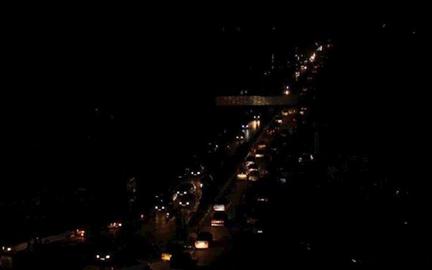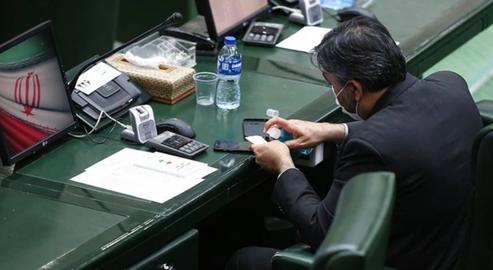Protests in Khuzestan over chronic water shortages began in mid-July this year. People have since taken to the streets in other Iranian cities in solidarity with their cause, chanting anti-government slogans and even tearing down banners of Supreme Leader Ali Khamenei.
Elsewhere in Iran, tensions have also flared up over the widespread power outages that have now plagued the country for months. When the electricity cuts out, people in major cities have been filmed screaming “Death to Khamenei” from their balconies. Hospital wards, high schools and businesses up and down the country have all ended up as collateral to the darkness.
At around noon on Tuesday this week, a large crowd formed up in central Tehran and marched down the busy Jomhouri Avenue, bringing traffic to a near-standstill and filling the air with the now-ubiquitous cry: “Mullahs get lost”. The protest coincided with a blackout at the Aladdin Mall, prompting a number of shopkeepers to come out and join the demonstration.
The nationwide electricity supply is one of the Iranian government's biggest problems, and is intimately connected to the water crisis. Poor resourcing, incompetence and short-sightedness are certainly key contributing factors to the power outages currently making a misery of Iranians’ day-to-day lives. But there is another part of the story to tell.
***
On July 22, 2021, Mohammad Hassan Asafari, deputy chairman of the Iranian parliament’s Internal Affairs Committee, gave a revealing interview to Fars News Agency about the worn-out state of Iran’s water and power networks. "Some former deputy ministers of energy,” he claimed, “built private power plants. But despite using government funding, they refused to provide the electricity they produced to the government."
The MP for Arak also castigated what he saw as a lack of oversight of Iran’s electricity sector, demanding to know what had happened to the additional 30,000 MW of capacity that was supposed to be added to the system under the Sixth National Development Plan.
These comments followed a more forthright diagnosis by Javad Imam, a former deputy minister of energy in Mohammad Khatami's government. Speaking to ILNA about the blackouts on July 8, Imam stated: "Power plants and companies have been handed over to the private sector. As a result, the Ministry [of Energy] has to buy electricity from these sectors at one and a half to two times the price – and sell it to the people at half price."
Taken together, these two politicians’ quotes give us some idea of the other factor gnawing at Iran’s electricity system: corruption. The so-called “privatization” of Iran’s energy sector left the government hostage to entities not fully within its control. Unlike the other issues, it could well be irreversible.
That “Privatization” Process in Full
The story began in 2010, when the Iranian Privatization Organization announced that 12 major state-run power plants would shortly be transferred to the private sector. That August, Seyed Hossein Abdol-Khaleghzadeh, who was tasked with overseeing the handover, told reporters that in order to boost competition at least three high-value plants would be auctioned off with a number of incentives attached.
These incentives included down-payments of just 10 to 20 percent, and the opportunity to pay in instalments over a period of five to 10 years. Abdol-Khaleghzadeh was blunt on where he thought the main interest lay: “What is certain is that organizations that have been leaders in the construction of power plants, such as the Mostazafan Foundation [a charitable foundation and Iran’s second-largest commercial entity, controlled by the Supreme Leader], Mapna Group and Shasta [a holding company owned by the Social Security Organization], are interested and will take the lead in the competition."
In essence, Abdol-Khaleghzadeh was saying the groundwork was being laid for state assets to be arbitrarily transferred to unaccountable, parastatal institutions with no experience or expertise in how to run them. Unfortunately he was right on the money.
Later on in 2010, Gilan Power Plant was sold off to Ghadir Investment Company: a powerful entity whose majority shareholder is the Armed Forces Social Security Organization. Mashhad Power Plant was sold to the Persian Gulf Energy Development Horizon Company, a contractor of the Supreme Leader-controlled Astan Quds Razavi foundation.
Also in 2010, Khoy Power Plant in West Azerbaijan was transferred to the Pasargad Energy Development Company, a subsidiary of Iran’s Pasargad Bank (itself created during a banking privatization drive in 2005). Qom Power Plant went to the Saba Electricity and Energy Industries Company, whose majority shareholder is the Mostazafan Foundation.
The following year, ownership of the Damavand Power Plant was handed to the parastatal Foundation of Martyrs and Veterans’ Affairs. Fars Power Plant was transferred to the still partly state-owned Tejarat Bank. The Sabalan-Ardabil power plant in northwestern Iran was handed over in 2011 to the Khatam al-Anbia Construction Headquarters, which is owned by the Islamic Revolutionary Guard Corps. The Toos Power Plant in Razavi Khorasan went to the Social Security Organization, while the Shahid Montazeri Power Plant north of Isfahan was sold to the Persia Steel Company (more on this later).
The Montazer Ghaem Power Plant in Alborz fell in 2011 into the hands of Sepehr Electricity and Energy Development Company: a subsidiary of Saderat Bank. The bank’s current chairman is Gholamreza Shafei, a former minister of industry. Its directors include the MP Mohammad Reza Tabesh and former president Mohammad Khatami's nephew.
Later in 2012, Abadan Power Plant in Khuzestan was handed over to the Executive Headquarters of Imam's Directive, better known as Setad: another massive parastatal conglomerate owned by the Supreme Leader of the Islamic Republic. Zagros Power Plant in Kermanshah also went to the Foundation of Martyrs and Veterans’ Affairs.
With the benefit of hindsight, it beggars belief that this three-year process during the tenure of President Mahmoud Ahmadinejad was ever referred to as “privatization”. In more than half of the cases lifted above, it was made plain at the time of transfer that Ministry of Energy assets were being handed over to cover government debts to some of the new owners.
Hamid Chitchian, a former Minister of Energy in Hassan Rouhani’s first government, confirmed the same to Islamic Republic of Iran Broadcasting (IRIB) during the last week of his tenure in August 2017. “The transfer of power plants to non-specialist institutions,” he said, “to cover debts to creditors such as the Martyrs' Foundation, the Ministry of Defense, and Social Security, is what took place under the ninth and tenth governments [during Ahmadinejad’s two terms]."
In practice, it meant that management of these plants shifted from the hands of qualified, accountable government officials to unspecialized and shady ones. In most cases, unelected actors within the Iranian regime continued to benefit financially – most notable among them, of course, Supreme Leader Ali Khamenei.
The Isfahan Power Plant Embroiled in a Corruption Scandal
The story of Shahid Montazeri Power Plant in Isfahan is somewhat different, and merits a closer look. In 2011 it was sold on to a little-known entity called Persia Steel Company, which was to pay for it in instalments. According to its official filings, Persia Steel was registered in 2002, and had increased its capital significantly in 2009.
The firm’s current board members include several members of the wealthy Falahatian family: Mehdi, Mohammad, Mohsen and Majid Falahatian, together with one Seyed Mansour Yazdanian. Mehdi Falahatian has since been sentenced to 10 years in prison for his part in the $165 million Mellat and Parsian Banks embezzlement scandal.
The long trajectory of the Shahid Montazeri Power Plant speaks for itself. As early as 2014, the facility, first built in 1985, was in a dilapidated enough state that ministers floated the idea of bringing in Russian state contractors to restore it. A 2016 study placed the efficiency of each of its eight units at a sub-par 35.2 percent.
In July 2020, Mohammad Taghi Naghadali, the MP for Khomeini Shahr in Isfahan, told Fars News Agency there was “no good news” he could report about Shahid Montazeri. Citing the extortionate prices being charged by the plant for electricity, Naghadali said “security, judicial and regulatory agencies” needed to involve themselves in its future.
“The reports about the quality of its transfer are not good at all,” he said. “It seems right that the monitoring bodies enter into this and interrogate the details. We have received numerous, successive reports – this isn’t a matter on which just one person has spoken – that at the time of the transfer, there was a problem with the pricing and payments, and that the whole case was tainted with corruption."
In addition to the neglected Isfahan power plant, in 2019 the Falahtian brothers owned about five percent of all shares in Iran’s Saderat Bank. Two years later during the 2021 presidential election debates, a list of 11 major Iranian bank debtors came to light. On this list, Mehdi Falahatian came in sixth.
Falahatian had been named in court as an accomplice of Ali Divandari, the CEO of Mellat and Parsian Banks. Both were eventually jailed, for 10 and 20 years respectively, for their part in the fraud. Both are also said to be among the prison’s “special cases”: convicted but well-connected financial criminals regularly allowed to take extended leave.
The indictment against Falahatian accused him of "participating in major disruption of the country's foreign exchange system through membership in fraudulent networks, obtaining illegal assets amounting to 389 million dirhams (US$108m) from Mellat Bank... [and] the illegal acquisition of 220 million dirhams ($61m) from Parsian Bank."
Prosecutors also alleged that some of the around $2.2 billion withheld from the state by billionaire swindler Babak Zanjani had been transferred across to Falahatian’s own bank account. "The gentlemen secretly gave government cash to Falahatian for eight months,” prosecutor’s assistant Rasoul Ghahremani Falahatian told the court. “During this period, Falahatian also happily made a profit of six million dirhams ($1.6m).
“Falahatian has declared Shahid Montazeri Power Plant as bail. But to date no bail has been extracted from the power plant and Falahatian's checks have bounced. With the power plant bail and check money not deposited, it was decided to allocate three percent of shares in Saderat Bank, owned by Falahatian, as bail. But after a while it became clear that even these shares were collateral for other debts."
The final indignity? In 2013, Falahatian’s Persia Steel Company had also won an auction for five percent of shares in the state-owned Iran Post Bank. At the time Persia Steel was officially still indebted to the Privatization Organization for the Shahid Montazeri Power Plant. But the Ministry of Energy then confirmed that Persia Steel was eligible to buy the bank shares anyway – because of the amount of money the Ministry now owed it for electricity.
All in all, about 80 percent of Iran’s power plant capacity is today either in the hands of non-specialist parastatal entities or individuals convicted in high-profile corruption cases. In recent months, the government has repeatedly deployed the dead cat of cryptocurrency mining (or the catch-all of sanctions) to explain the country’s ongoing, disastrous blackouts. Iranians on the streets, meanwhile, blame mismanagement generally and the Supreme Leader personally. They are closer to the mark; if the Iranian regime truly wants to fix Iran’s decaying electricity infrastructure, it needs to start by looking within.
Related coverage:
What Role has Ayatollah Khamenei Played in Iran's Blackouts?
Ruined Bread to Pitch-Black Hospital Wards: Iranians' Fury at Power Outages
Blackouts in Iran: Why is the Electricity Deficit So High This Summer?
Dispatch from Tehran: Blackouts Leading to Bankruptcy
Water Tariffs to Increase in Iran Ahead of Summer Shortages
Fact File: Did Bitcoin Mining Lead to Blackouts in Iran?
Government Report Reveals More Corrupt Privatization Practices in Iran
Oil Strikes in Iran: What are the Contract Workers' Demands?
Who are the Economic Freeloaders Hemmati Complains About?
visit the accountability section
In this section of Iran Wire, you can contact the officials and launch your campaign for various problems






























comments